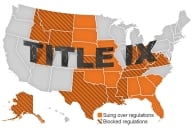You have /5 articles left.
Sign up for a free account or log in.
Nearly a third of young people with disabilities have taken at least some postsecondary classes within the first two years after they leave high school, according to a U.S. Education Department study released Thursday. The study finds that disabled students over all are less than half as likely as their peers to have attended college in the two years after high school, but the college-going rate varies greatly by type of disability: Students with hearing or visual impairments are as likely as nondisabled students to have done some postsecondary work.
The report of the study, "After High School: A First Look at the Postschool Experiences of Youth With Disabilities," was prepared by SRI International, a research group, for the Education Department's Office of Special Education Programs. Its underlying purpose is to help gauge the success of federal laws and programs aimed at ensuring that elementary and secondary schools prepare young people with disabilities for later life. But along the way, the study provides some unusually in-depth data about a relatively little-studied group of college students.
The study looked at a group of students who were in high school in 2001 and who had finished or left high school two years later.
Of those, 31 percent of disabled students had attended a postsecondary institution since leaving high school, although a small proportion of those were attending college exclusively (most were working, too). Nearly 20 percent of the students were attending college currently at the time the study was conducted in 2003, just under half of the proportion for the general population.
Disabled students were far less likely than their peers to attend a four-year institution: 5.7 percent were enrolled at a four-year institution in 2003, compared to 28.3 percent of all students. But disabled students were nearly as likely as other students (9.7 percent versus 12.2 percent) to be enrolled at a community or two-year college. Another 5 percent of disabled students were attending postsecondary vocational, business, or technical schools in 2003.
Among the study's other key findings:
- Fewer disabled students went on to college than were expecting to. About 77 percent of students interviewed while in high school said they aspired to get a postsecondary education, but only 31 percent had taken some postsecondary classes in the period after they finished. But students who aspired to go to college were far more likely to do so: Only 5 percent of those who did not envision attending postsecondary school have enrolled in two-year colleges, compared with 36 percent of those who expressed the goal of attending a two- or four-year institution.
- Students with disabilities were less likely than their peers to be expected to go to college. Sixty-one percent of parents of young people with disabilities expected them to get a postsecondary education, compared to 92 percent of those in the general population.
- 67 percent of students with hearing impairments and 69 percent of students with visual impairments had attended some college since high school. They were also far likelier than other disabled students to be at a four-year college; 40 percent of them had enrolled in such colleges. Only one in five students with emotional disabilities had received some postsecondary education since they left high school.
- Nearly 80 percent of disabled students who had attained some postsecondary education were enrolled steadily, and three-quarters were enrolled full time.
- About two-thirds of postsecondary students with disabilities received no accommodations from their colleges. That was attributed in large part to the fact that about half of postsecondary students with disabilities said they do not consider themselves to have a disability, and another 7 percent acknowledged having a disability but had not told their colleges about it.
In one other noteworthy way, disabled students were very much like their peers: They show a gender gap in college-going rates. Female students with disabilities were 6 percentage points more likely than male students to have enrolled in college since high school, controlling for other differences.









